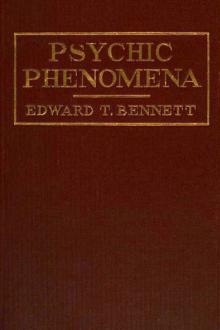The Beautiful by Vernon Lee (red queen free ebook .txt) 📖

- Author: Vernon Lee
- Performer: -
Book online «The Beautiful by Vernon Lee (red queen free ebook .txt) 📖». Author Vernon Lee
I therefore commend to the Reader the now somewhat unfashionable hypothesis of Semper and his school, according to which the first preference for beauty of shape must be sought for in those arts like stone and metal work, pottery and weaving, which give opportunities for repetition, reduplication, hence rythm and symmetry, and whose material and technique produce what are called geometric patterns, meaning such as exist in two dimensions and do not imitate the shapes of real objects. This theory has been discredited by the discovery that very primitive and savage mankind possessed a kind of art of totally different nature, and which analogy with that of children suggests as earlier than that of pattern: the art which the ingenious hypothesis of Mr Henry Balfour derives from recognition of accidental resemblances between the shapes and stains of wood or stone and such creatures and objects as happen to be uppermost in the mind of the observer, who cuts or paints whatever may be needed to complete the likeness and enable others to perceive the suggestion. Whether or not this was its origin, there seems to have existed in earliest times such an art of a strictly representative kind, serving (like the spontaneous art of children) to evoke the idea of whatever was interesting to the craftsman and his clients, and doubtless practically to have some desirable magic effect upon the realities of things. But (to return to the hypothesis of the aesthetic primacy of geometric and non-representative art) it is certain that although such early representations occasionally attain marvellous life-likeness and anatomical correctness, yet they do not at first show any corresponding care for symmetrical and rythmical arrangement. The bisons and wild boars, for instance, of the Altamira cave frescoes, do indeed display vigour and beauty in the lines constituting them, proving that successful dealing with shape, even if appealing only to practical interest, inevitably calls forth the empathic imagination of the more gifted artists; but these marvellously drawn figures are all huddled together or scattered as out of a rag-bag; and, what is still more significant, they lack that insistence on the feet which not only suggests ground beneath them but, in so doing, furnishes a horizontal by which to start, measure and take the bearings of all other lines. These astonishing palaeolithic artists (and indeed the very earliest Egyptian and Greek ones) seem to have thought only of the living models and their present and future movements, and to have cared as little for lines and angles as the modern children whose drawings have been instructively compared with theirs by Levinstein and others. I therefore venture to suggest that such aesthetically essential attention to direction and composition must have been applied to representative art when its realistic figures were gradually incorporated into the patterns of the weaver and the potter. Such "stylisation" is still described by art historians as a "degeneration" due to unintelligent repetition; but it was on the contrary the integrating process by which the representative element was subjected to such aesthetic preferences as had been established in the manufacture of objects whose usefulness or whose production involved accurate measurement and equilibrium as in the case of pottery or weapons, or rythmical reduplication as in that of textiles.
Be this question as it may (and the increasing study of the origin and evolution of human faculties will some day settle it!) we already know enough to affirm that while in the very earliest art the shape-element and the element of representation are usually separate, the two get gradually combined as civilisation advances, and the shapes originally interesting only inasmuch as suggestions (hence as magical equivalents) or things, and employed for religious, recording, or self-expressive purposes, become subjected to selection and rearrangement by the habit of avoiding disagreeable perceptive and empathic activities and the desire of giving scope to agreeable ones. Nay the whole subsequent history of painting and sculpture could be formulated as the perpetual starting up of new representative interests, new interests in things, their spatial existence, locomotion, anatomy, their reaction to light, and also their psychological and dramatic possibilities; and the subordination of these ever-changing interests in things to the unchanging habit of arranging visible shapes so as to diminish opportunities for the contemplative dissatisfaction and increase opportunities for the contemplative satisfaction to which we attach the respective names of "ugly" and "beautiful."
CHAPTER XIV
THE AIMS OF ART
WE have thus at last got to Art, which the Reader may have expected to be dealt with at the outset of a primer on the Beautiful.
Why this could not be the case, will be more and more apparent in my remaining chapters. And, in order to make those coming chapters easier to grasp, I may as well forestall and tabulate the views they embody upon the relation between the Beautiful and Art. These generalisations are as follows:
Although it is historically probable that the habit of avoiding ugliness and seeking beauty of shape may have been originally established by utilitarian attention to the non-imitative ("geometrical") shapes of weaving, pottery and implement-making, and transferred from these crafts to the shapes intended to represent or imitate natural objects, yet the distinction between Beautiful and Ugly does not belong either solely or necessarily to what we call Art. Therefore the satisfaction of the shape-perceptive or aesthetic preferences must not be confused with any of the many and various other aims and activities to which art is due and by which it is carried on. Conversely: although in its more developed phases, and after the attainment of technical facility, art has been differentiated from other human employment by its foreseeing the possibility of shape-contemplation and therefore submitting itself to what I have elsewhere called the aesthetic imperative, yet art has invariably started from some desire other than that of affording satisfactory shape-contemplation, with the one exception of cases where it has been used to keep or reproduce opportunities of such shape contemplation already accidentally afforded by natural shapes, say, those of flowers or animals or landscapes, or even occasionally of human beings, which had already been enjoyed as beautiful. All art therefore, except that of children, savages, ignoramuses and extreme innovators, invariably avoids ugly shapes and seeks for beautiful ones; but art does this while pursuing all manner of different aims. These non-aesthetic aims of art may be roughly divided into (A) the making of useful objects ranging from clothes to weapons and from a pitcher to a temple; (B) the registering or transmitting of facts and their visualising, as in portraits, historical pictures or literature, and book illustration; and (C) the awakening, intensifying or maintaining of definite emotional states, as especially by music and literature, but also by painting and architecture when employed as "aids to devotion." And these large classes may again be subdivided and connected, if the Reader has a mind to, into utilitarian, social, ritual, sentimental, scientific and other aims, some of them not countenanced or not avowed by contemporary morality.
How the aesthetic imperative, i.e. the necessities of satisfactory shape-contemplation, qualifies and deflects the pursuit of such non-aesthetic aims of art can be shown by comparing, for instance, the mere audible devices for conveying conventional meaning and producing and keeping up emotional conditions, viz. the hootings and screechings of modern industrialism no less than the ritual noises of savages, with the arrangements of well constituted pitch, rythm, tonality and harmony in which military, religious or dance music has disguised its non-aesthetic functions of conveying signals or acting on the nerves. Whatever is unnecessary for either of these motives (or any others) for making a noise, can be put to the account of the desire to avoid ugliness and enjoy beauty. But the workings of the aesthetic imperative can best be studied in the Art of the visual-representative group, and especially in painting, which allows us to follow the interplay of the desire to be told (or tell) facts about things with the desire to contemplate shapes, and to contemplate them (otherwise we should not contemplate!) with sensuous, intellectual and empathic satisfaction.
This brings us back to the Third Dimension, of which the possession is, as have we seen, the chief difference between Things, which can alter their aspect in the course of their own and our actions, and Shapes, which can only be contemplated by our bodily and mental eye, and neither altered nor thought of as altered without more or less jeopardising their identity.
I daresay the Reader may not have been satisfied with the reference to the locomotor nature of cubic perception as sufficient justification of
 A very interesting statement of one of our contemporaries is that any person, to one degree or another, is both a psychologist and a philosopher - they say, life forces him to. On the one hand, the main driving force of every person is the craving for knowledge, the desire to reach certain social heights, the desire to be wise in any everyday situations - and this is the philosophy of life.
A very interesting statement of one of our contemporaries is that any person, to one degree or another, is both a psychologist and a philosopher - they say, life forces him to. On the one hand, the main driving force of every person is the craving for knowledge, the desire to reach certain social heights, the desire to be wise in any everyday situations - and this is the philosophy of life. 




Comments (0)